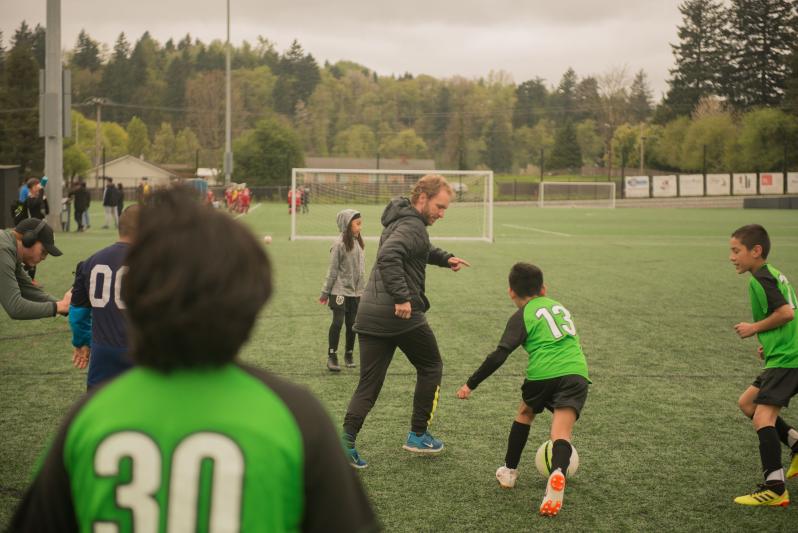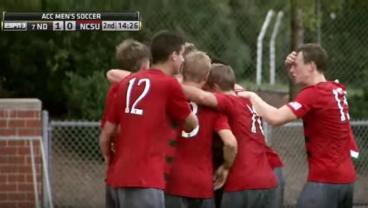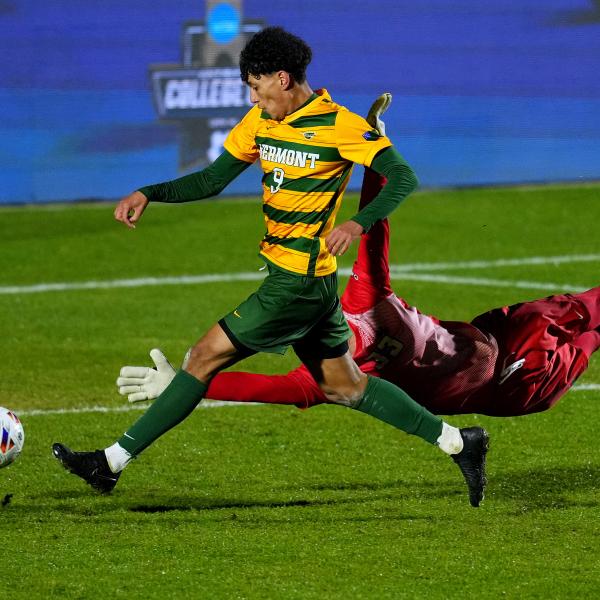How do you fix youth soccer in the U.S.? Where do you even begin?
It’s too expensive, too exclusive, too unwilling to change. The underprivileged are unable to join in, minorities too often forgotten.
On a systemic level, the task at hands appears almost Sisyphean in scope. How do you change an entire culture built around a pay-to-play model, one that has stagnated the development of countless young athletes, not to mention the U.S. men’s national team? How do you give all young people, regardless of background, a chance?
PCFC, for one, is a start.
Portland Community Football Club represents everything the U.S. Soccer Federation has, for years, failed to support. And it represents a way forward for an anti-classist and anti-racist — but still competitive — vision for youth soccer in America.
Founded in 2013 by Kaig Lightner, PCFC provides elite-level playing and coaching to underserved communities in Portland. In a region where top clubs cost at least $2,000 per year (per child), PCFC’s season fees are less than $80 with further financial aid available. The club’s mission statement promises to fulfill the promise of giving all children the opportunity to play high-quality soccer, focusing on immigrant, refugee and low-income black, brown and white children from age 3-18 in the Portland Metro area.
Paying To Play
In most countries around the world, including those with the most historical success on the global stage, soccer is an egalitarian sport. Everyone is given an opportunity to excel with little to no financial barriers limiting the growth of players.
Soccer in the U.S., on the other hand, is expensive, particularly at the highest levels required to get noticed by national-team programs. While basketball has the established AAU and football is still built around high schools and colleges, soccer remains a club-based sport. In many areas of the country, this can mean exorbitant cost burdens placed on families.
Zlatan Ibrahimovic, the highest-paid footballer in the country in 2019, recently lamented how costly it was for his kids to play soccer whilst he lived in Los Angeles. He had to fork over $3,500 per year for each of his two sons to play soccer. While $7,000 is nothing to a multimillionaire, it’s a huge obstacle for most families across the country.
Portland Community Football Club was founded to provide opportunities to players and families who otherwise could not afford top-level soccer. The average family income of PCFC players is from $25,000-$40,000, with more than 95 percent of players coming from communities of color.
Playing To Win
Portland Community Football Club currently supports seven to 10 teams around the year from the U-6 to U-15 age levels. But these aren’t just rec-league clubs out there having fun. These are teams out there to compete.
There are many affordable programs around the country, but few are able to provide high-quality soccer, which is important, Lightner said.
“Too often it’s the low-income, kids of color and marginalized kids who have no other option than these lower level options,” he said. “As a result, they never get a chance to find out how successful they can be in this sport. Not only because they aren’t getting the coaching to improve their skills, but they are probably seeing their affluent, mostly white, peers coming to school in their slick club gear. That further reinforces our society’s messaging that one’s ability to find success depends on how much money you make, not on your talent.
“Kids coming from communities where they may see despair, poverty and rejection more often than success need to be given the chance to excel at this level.”
And they have succeeded at this level.
In 2017, the U-10 team won the first major tournament for which it ever signed up, winning the final at Providence Park, home of the Portland Thorns and Timbers. That team is now playing one step below Premier at the U-13 level and lost in the semifinals of the President’s Cup this year. Another U-10 team is also currently playing at the state level.
“The greatest part of this success is they are playing against teams from the largest clubs in Portland, which goes to show that you don’t need thousands of dollars to be a successful team,” Lightner said.
But supporting an affordable club doesn’t come without its challenges.
Making It Work
PCFC has two annual sponsors: a local bar called The Florida Room and the Tottenham Spurs Supporters Club (Portland Spurs). The club has also received grants, donations and equipment from the likes of Nike, adidas, Multnomah Athletic Foundation, Autzen Foundation and a private family foundation, as well as a growing base of individual backers. (Click here to learn you can help.)
But it isn’t easy to find the funding necessary.
The club has an annual budget of around $60,000, far below the larger clubs in the area with budgets reaching $1 million, which isn’t abnormal around the country. As an example, the club that helped produce Christian Pulisic costs $300,000 per year for just one age group.
Even PCFC’s limited cost requires financial backing for something many people don’t even realize is needed.
“The challenge is first in educating funders, supporters, sponsors about the issue,” Lightner said. “Many people don't understand how expensive and exclusive the competitive system is. They just think it’s kid’s soccer and everyone gets a chance to play.
“The other issue we’ve encountered is the fact that we’re a competitive club. We were actually denied a $5,000 grant from the Timbers Stand Together fund because of this fact. The reason being that we were seen as competition to their affiliate clubs and they couldn’t justify providing us with funding.”
With the money PCFC does raise, the club offers affordable season fees, free uniforms and shin guards and cleats as needed.
The club retains a staff of five head coaches and six assistant coaches, all of whom are volunteers with full-time jobs. Director of Coaching Mark Lawton, another volunteer, helps create structure for all of the coaches to improve (and train young coaches). Lightner himself, the club director, is part time too; he runs a consulting business Quantum Gender and teaches part time at Portland State University.
Holding it all together is Carolina Hernandez Morales, the Program Director. She manages all of the teams’ day-to-day tasks. More importantly, she connects with every family on a personal level to provide additional support where needed, whether it’s helping out a single mom who just received a 72-hour eviction notice or supporting a family whose father was injured on the job and would be out of work for an indeterminate amount of time.
“Carolina and these coaches make PCFC what it is today,” Lightner said. “We have a relationship with all our families so that when they ask us for help we help them, no questions asked.”
It’s this sense of community that you so rarely find in youth soccer in America, where most clubs are focused on winning (and, often, making money).
Celebrating Diversity
Vital to PCFC’s ethos is being one of the few youth soccer clubs that openly encourages LGBTQ+ players, coaches and parents. Lightner said he has yet to find another youth club like PCFC in this regard.
“You might be able to find it buried on a webpage about their non-discrimination clause, but that’s certainly not the way to show your acceptance of a population of people who are shunned in the athletic world,” Lightner said. “And that’s why it’s so important to be bold and open about that acceptance.
“For players and coaches that means they get to flourish and be fully focused on being an athlete or coach. And for parents that means they can cheer their kids on without wondering if they belong there.”
Celebrating and welcoming those in the LGBTQ+ community is especially important to Lightner, who identifies as a queer, transgender man.

Kaig Lightner coaches players during a PCFC practice. Photo courtesy PCFC.
In 2017, Lightner came out to his players and inadvertently created a viral moment picked up by national media, including Good Morning America.
“I had just gotten to this place with them that I thought they need to know and deserve to know,” Lightner said at the time. “I thought it was really fantastic that the first question was, ‘How old are you?’ Kids don’t have as many concerns about these larger social issues as adults do. They just want to know what age I am.”
Within this community, all PCFC teams are co-ed, which means they all play in boys divisions. The decision to play co-ed was made more out of a lack of numbers initially, but it had positive side effects.
“It has provided a fantastic opportunity to dismantle stereotypes about girls’ athletic ability,” Lightner said. “Our goal is to place players on teams that match their skill level regardless of their gender identity.”
Initially some of the boys were hesitant, Lightner said, but now they regularly stand up for their female teammates on and off the pitch while recognizing the skills they bring to the team.
“I feel like I get more challenge with the boys and more confidence,” said one female player in the above short documentary video.
Way Forward
After the USMNT failed to qualify for the 2018 World Cup, U.S. Soccer was mostly quiet. The USSF elected a new president, who was in many ways same as the old boss, and lost a number of high-profile dual nationals to Mexico before finally unveiling its first attempt to fix the system: the introduction of bio-banding.
But U.S. Soccer did nothing to combat the endemic problem of pay-to-play in this country. While the USSF does offer scholarships, despite its massive financial clout, the non-profit provided a mere 565 scholarships at an average of $1,500 each across the entire country for the 2018-19 season.
“This issue of affordability is hindering our country’s ability to recruit the most-talented players for both national teams,” Lightner said. “It’s nearly impossible to make your way to the highest level of the sport in the U.S. unless you begin playing in the elite system at a very young age.
“I think we should look at Germany and how they transformed their system after the loss in 2000 at the Euros to begin a nation-wide campaign to increase their reach into small towns to find undiscovered talent. But of course, we’re in the U.S. where soccer is still mocked far more often then it’s revered.”

A PCFC U-7 squad. Photo courtesy PCFC.
Lightner said he thinks one of the biggest problems is how opaque the entire U.S. soccer system is.
“The big push towards professionalizing the game at the youth level in the U.S. over the past couple of decades has increased the cost from player fees to coaching licensure,” Lightner said. “I appreciate the intention of creating a higher-quality platform in the U.S. for players and coaches, but the impact has been that low-income players and coaches are left behind.”
Figuring out how to provide opportunities to play high-level soccer across the board is the ultimate question for U.S. Soccer.
“I think the best way forward is for serious system reform,” Lightner said, before rattling off half a dozen ideas that could be executed easily if the USSF truly wanted to fix the system. Such ideas include requirements for big clubs to provide full scholarships to at least 10 percent of their players, slashing season fees for clubs from low-income areas and wealthier clubs partnering with school-based programs to provide coaching and education opportunities for kids to play in the larger clubs.
Of the more interesting ideas that could be implemented immediately, Lightner suggested all clubs be required to provide equity training so when kids from underserved communities do join the team, the club has an understanding of the trauma and oppression the kids experience every day.
“Even if USSF were to increase scholarship funds or lower the fees there is still the larger task of changing the culture of soccer in the U.S. from one of affluent white dominance to embracing people of all income levels and life experiences,” Lightner said.
Connecting with players of all backgrounds has cost the USMNT in recent years, with players such as young LA Galaxy star Efrain Alvarez, choosing to switch allegiances to Mexico.
Unfortunately, Lightner didn’t sound too optimistic the current U.S. Soccer leadership will be able to change things.
“If you look at the current USSF leadership it is overwhelmingly white and male,” Lightner said. “It’s less likely those leaders are able to not only understand what communities of color are experiencing but to have the ability to think creatively and boldly about how to change the system.”
***
Fortunately, there is a path.
As Portland Community Football Club has shown, affordable, high-quality, egalitarian soccer is attainable in an increasingly diverse America.
Now it just needs to become the norm rather than the exception.







